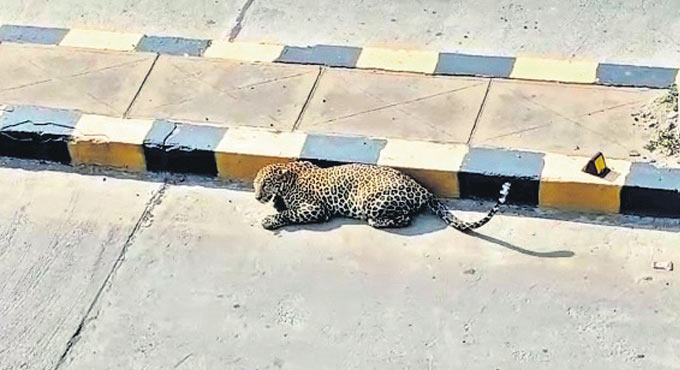Hyderabad: In the past few months, there have been quite a few instances of leopards being spotted in urban areas and rural habitats, from Rajendra Nagar a few months ago to one in Malkapur in Karimnagar a week ago, and the one near the Rajiv Gandhi International Airport at Shamshabad just this week.
While social media accounts and WhatsApp groups had a blast sharing the images and discussing the dangers of a leopard being spotted in the city, the fact that these large felines are being spotted in human areas is an alarming sign of the rapid urbanisation that has made us enter their areas, point out animal activists.
According to a senior official with the Forest Department, the rapid urbanisation is the top reason for the wildlife spottings. “Predatory animals exist wherever there are prey species and water sources. Peafowl, porcupines, hares and other such species are natural preys for leopards and Hyderabad is surrounded by areas which have these species. The city grew rapidly, expanding into hillocks, taking over lakes and the other natural areas of these species and that is why we are spotting these carnivorous animals in the city,” the official explained.
Humans are entering the animal habitats and destroying them. It is not the other way around. The Deccan plateau, which encompasses Hyderabad, is rich in granite and granite quarries have also led to rapid decline of the species’ habitats.
“Hillocks around the city have been flattened, granite rich areas have been turned into quarries and all this took away the areas natural to the animals. Expansion is a necessity but it need to be planned. Unplanned expansion is also affecting various other species of flora and fauna. For instance, a lot of bird species native to this region of Telangana are disappearing,” he explains.
Agreeing with this is an avid birder, Kalyan Ineni. “I have been birding for years now and I have noticed a lot of patterns in birds behaviour and the reduction in their numbers. The water bodies in the city now have lakefront apartments next to them and human activity drives birds away. This has been evident at various spots, like the Ameenpur lake for example. I used to see thousands of birds there 7 to 8 years ago but now the numbers are far low,” explains Kalyan.
In a scenario like this, what can be the solution? A retired forest official points out, “Clear demarcation of conservation zones along with planned expansion of the city in a manner that is sensitive to the local environment are the only options we have. Otherwise, our survival is also at stake in the longer run if we continue destroying the ecology.”
But, according to Kalyan demarcation of conservation zones is just a part of the solution. “The city grew rapidly in the last 10 years and while the urban areas ended a few kms before the ORR line, they are now beyond the ORR. This has brought in human activity even near the conservation zones. The Narsapur forest range is hardly a couple of kms from the ORR exit point at Gandimaisamma. The closer human activity gets to wildlife, the higher the chances of interactions and possible driving away of wildlife,” he explains.
Now you can get handpicked stories from Telangana Today on Telegram everyday. Click the link to subscribe.
Click to follow Telangana Today Facebook page and Twitter .
